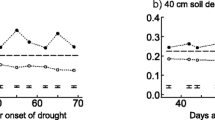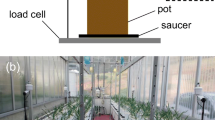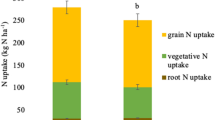Abstract
Spring wheat cv. ‘Gutha’ was grown in continuous wheat (W/W) and narrow-leafed lupin (L. angustifolius L. cv. Yandee)-wheat (L/W) rotation on a yellow earth over mottled clay (Arenic Fragiudult) in a mediterranean climate for two years. The first year had a higher than average rainfall with adequate soil water until anthesis. The second year was very dry (only 232 mm total rainfall) and soil water contents were low throughout the growing season. Nitrogen fertilizer (+N) treatments were included in both years. In the first year an adjacent experiment compared the effects of loosening a pronounced traffic pan which existed on the site (LS)versus unloosened (US).
In the first year roots contained more dry matter than tops in the early vegetative stage in all crops and then declined exponentially to a ratio of 0.1 in the US and LS treatments. In the second year however, the decline was both linear and much less, so that root:shoot ratios at harvest were still between 0.4 and 0.8. There was a consistent trend in root:shoot ratios from the most favourable (LS) to least favourable (W/W-N) treatments over the combined two years’ data, and this was also found in grain yield, with a higher yield in year one from the LS than US, and the lowest yield in year two from the W/W-N treatment. The proportion of total biomass recovered from below ground was substantially higher than is commonly reported from studies carried out in temperate, high fertility soils, but probably still under-estimates of the true amount of dry matter in roots because of inadequacies of sampling, washing and storage techniques.
Root length densities were much greater in the drier year, especially in the surface 0.1-m, and based on theoretical considerations, much greater than required for extraction of available water. The effect of environmental conditions on the relative size of cereal crop carbon sinks are discussed in relation to these results.
Similar content being viewed by others
References
Atwell B J 1990 The effect of soil compaction on wheat during early tillering. III. Carbon cycling and carbon balance. New Phytol. (In press.)
Belford R K, Klepper B and Rickman R W 1987 Studies of intact shoot-root systems of field grown winter wheat. II. Root and shoot developmental patterns as related to nitrogen fertilizers. Agron. J. 79, 310–319.
Bettenay E and Hingston F J 1961 The soils and land use of the Merredin area, Western Australia, CSIRO Aust. Div. Soils. Soil Land Use Series No 41.
Böhm W 1979 Methods for studying root systems. Ecological Studies No 33. Springer Verlag, Berlin, New York. 188 p.
Carmi A and Koller D 1979 Regulation of photosynthetic activity in primary leaves of bean (Phaseolus vulgaris L.) by materials moving in the water conducting system. Plant Physiol. 64, 285–288.
Cowan I R 1965 Transport of water in the soil-plant atmosphere system. J. Appl. Ecol. 2, 221–239.
Gibb R J 1986 Changes in Soil Structure under Different Cropping Systems. PhD thesis. University College Lincoln, NZ.
Hamblin A P and Hamblin J 1985 Root characteristics of some temperate legume species and varieties on deep, free-draining entisols. Aust. J. Agric. Res. 36, 63–72.
Hamblin A P and Tennant D 1987 Root length density and crop water uptake: How well are they correlated? Aust. J. Agric. Res. 38, 513–27.
Hamblin A P, Tennant D and Perry M W 1987 Management of soil water for wheat production in Western Australia. Soil Use Manag. 3, 63–69.
Henderson C 1986 Response of crops and pastures to soil compaction. pp 52–59.In A Review of Deep Tillage Research in Western Australia. Ed. M W Perry. Western Aust. Dept. Agric. Plant Res. Div. Tech. Rep. 3.
Henderson C, Levett A and Lisle D 1988 The effects of soil water content and bulk density on the compactibility and soil penetration resistance of some Western Australian sandy soils. Aust. J. Soil Res. 26, 391–400.
Lambers H 1987 Growth, respiration, exudation, and symbiotic associations: The fate of carbon translocated to the roots.In Root Development and Function. pp 125–175. Eds P J Gregory, J U Lake and D A Rose. 206 p. Society for Experimental Biology: Seminar Series 30 Cambridge University Press.
Lupton F G H, Oliver R H, Ellis F B, Barnes B T, Howse K R, Welbank P J and Taylor P J 1978 Root and shoot growth of semi-dwarf and taller winter wheats. Ann. Appl. Biol. 77, 129–144.
Marschner H 1986 Mineral Nutrition in Higher Plants: Phytohormones and Source-sink Relationships. pp 143–148: 5.6.4. Academic Press, Florida, 674 p.
Masle J and Passioura J B 1987 The effect of soil strength on the growth of young wheat plants. Aust. J. Plant. Physiol. 14, 643–656.
O’Toole J C and Bland W L 1988 Genotypic variation in crop plant root systems. Adv, Agron. 41, 91–145.
Schultz J E 1974 Root development of wheat at the flowering stage under different cultural practices. Agric. Res. 1, 12–17.
Sharp R E and Davies W J 1985 Root growth and water uptake by maize plants in drying soil. J. Exp. Bot. 36, 1441–1456.
Spiertz J H J and Ellen J 1978 Effect of nitrogen on crop development and grain growth of winter wheat in relation to assimilation and utilization of assimilates and nutrients. Neth. J. Agric. Sci. 26, 210–231.
Smucker A J M 1984 Carbon utilization and losses by plant root systems. pp 27–46.In Roots, Nutrient and Water Influx, and Plant Growth. A.S.A. Special Publication No 49. SSSA-CSSA-ASA Madison, WI.
Tennant D 1976 A test of a modified line-intersect method of estimating root length. J. Ecol. 63, 995–1103.
Tennant D 1986 Effects of deep tillage on root growth and water use of wheat in Western Australia. Ed M W Perry. West. Aust. Dept. Agric. Plant Res. Div. Tech. Rep. 3.
Vartanian N 1981 Some aspects of structural and functional modifications induced by drought in root systems. Plant and Soil 63, 83–92.
Ward J K, Klepper B, Rickman R W and Allmaras R R 1978 Quantitative estimation of living wheat root lengths on soil cores. Agron. J. 70, 675–7.
Welbank P J, Gibb M J, Taylor P J and Williams E D 1974 Root growth of cereal crops. Rothamsted Report for 1973 (2), 26–66.
Wilson A J, Robards A W and Goss M J 1977 Effects of mechanical impedance on root growth in barley (Hordeum vulgare L.) J. Exp. Bot. 28, 1216–1226.
Author information
Authors and Affiliations
Rights and permissions
About this article
Cite this article
Hamblin, A., Tennant, D. & Perry, M.W. The cost of stress: Dry matter partitioning changes with seasonal supply of water and nitrogen to dryland wheat. Plant Soil 122, 47–58 (1990). https://doi.org/10.1007/BF02851909
Received:
Issue Date:
DOI: https://doi.org/10.1007/BF02851909




